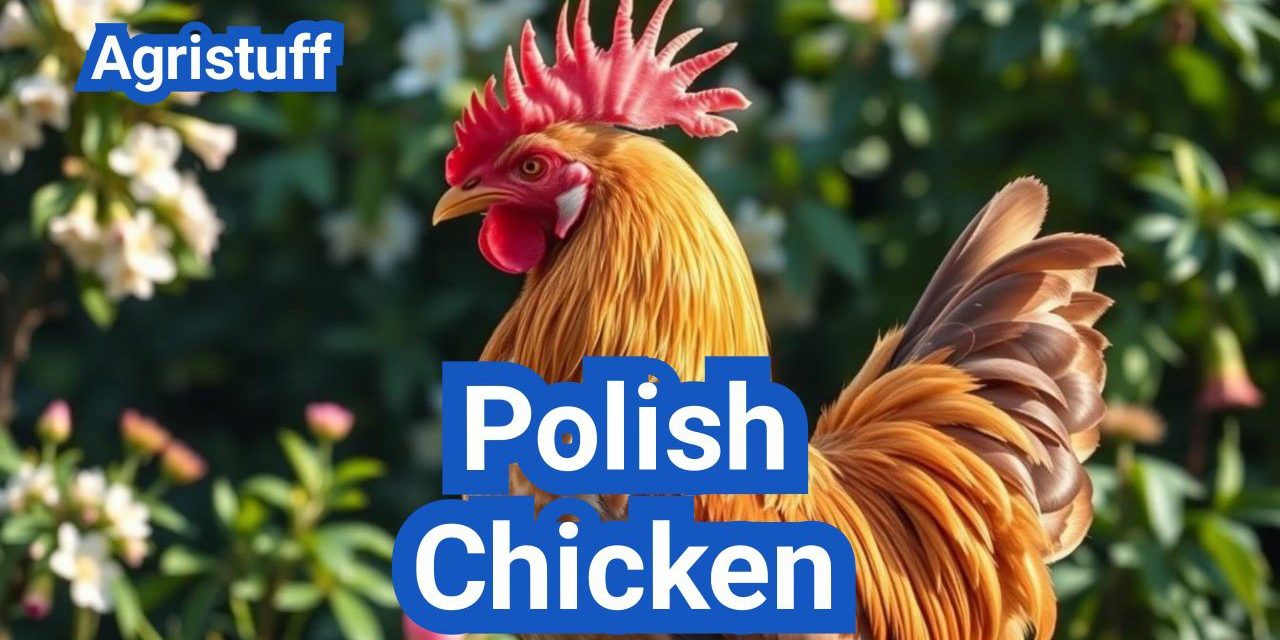The Polish Chicken is a distinctive poultry breed renowned for its striking appearance and unique crest of feathers on top of its head. This elegant breed has been a favorite among poultry enthusiasts for centuries due to its ornamental characteristics.
Initially developed for ornamental purposes, the breed stands as a true living work of art with its regal crest and aura of distinction. The Polish Chicken is known for its beautiful appearance and is considered one of the ornamental chicken breeds that add a touch of elegance to any flock.
Key Takeaways
- The Polish Chicken is a unique and distinctive poultry breed.
- It is known for its ornamental and striking appearance.
- The breed has a regal crest of feathers on top of its head.
- It is considered one of the elegant breeds among ornamental chicken breeds.
- The Polish Chicken has been a favorite among poultry enthusiasts for centuries.
The History and Origin of Polish Chickens
Originating in Eastern Europe, the Polish chicken breed has a fascinating history. While the exact origins are shrouded in mystery, it is widely believed that this breed emerged in the regions of Poland or the Netherlands. The unique crest of feathers on top of their heads made them a prized ornamental breed.
Ancient Origins and European Development
The development of the Polish chicken breed in Europe is a story that spans centuries. The breed was highly valued for its distinctive appearance and was often kept by European nobility. Their crested heads and elegant plumage made them a favorite among aristocrats, who showcased them in ornamental flocks.
Historical records suggest that the Polish chicken was first mentioned in the 16th century, although it’s likely that the breed existed before then. Over time, breeders selectively bred the Polish chicken to enhance its unique features, resulting in the various color varieties we see today.
Introduction to the United States
The Polish chicken was introduced to the United States in the mid-19th century, where it quickly gained popularity among poultry enthusiasts. American breeders were drawn to the breed’s ornamental value and began to breed them for exhibition purposes.
The introduction of the Polish chicken to the US marked a new chapter in the breed’s history, as American breeders contributed to its further development and diversification.
Recognition as a Standard Breed
In 1874, the American Poultry Association (APA) recognized the Polish chicken as a standard breed, solidifying its place in the world of poultry. This recognition was a significant milestone, as it acknowledged the breed’s unique characteristics and encouraged further breeding efforts.
The APA’s recognition of the Polish chicken helped to standardize the breed, ensuring that its distinctive features were preserved for future generations.
Understanding the Polish Chicken Breed

With its striking crest and varied feather colors, the Polish Chicken is a standout breed. This breed is known for its unique appearance, which sets it apart from many other poultry breeds.
Size and Weight Standards
The Polish Chicken is a medium-sized breed. Hens typically weigh around 4-5 pounds, while roosters weigh around 5-6 pounds. Their size makes them a manageable addition to many backyards.
| Bird Type | Weight Range (lbs) |
|---|---|
| Hens | 4-5 |
| Roosters | 5-6 |
The Distinctive Crest Feature
The most notable feature of the Polish Chicken is the crest of feathers on top of their heads. This crest can be quite large and is a hallmark of the breed. The crest is made up of feathers that grow upwards and outwards, giving the chicken a unique and somewhat comical appearance.
Body Structure and Appearance
Polish Chickens have a slender body and are known for their elegant appearance. They come in a variety of feather colors and patterns, including white, black, golden, and silver laced, among others. Their body structure, combined with their beautiful feathering, makes them a popular choice for those who appreciate ornamental breeds.
Breed Purpose: Ornamental vs. Utility
The Polish Chicken is primarily considered an ornamental breed. While they do lay eggs, their egg production is not as high as some other breeds. Their main purpose is for show and companionship, making them a great choice for backyard flocks where aesthetics and personality are valued.
Popular Polish Chicken Color Varieties
The Polish chicken breed boasts an impressive array of colors, from the striking white crested black to the elegant golden laced. This diversity in color adds to their ornamental appeal, making them a favorite among backyard chicken keepers and poultry enthusiasts alike.
White Crested Black Polish
The White Crested Black Polish is one of the most recognizable varieties, known for its sleek black plumage and contrasting white crest. This striking color combination makes them stand out in any flock.
Golden and Silver Laced Polish
Golden and Silver Laced Polish chickens are admired for their intricate feather patterns. The golden laced variety features a warm, golden hue, while the silver laced has a crisp, silver sheen. Both are highly prized for their beauty.
Buff Laced Polish Chickens
Buff Laced Polish chickens have a warm, buff-colored plumage with delicate lacing, adding to their visual appeal. This variety is cherished for its soft, inviting appearance.
White Crested Blue Polish
The White Crested Blue Polish is another striking variety, featuring a slate-blue plumage paired with a white crest. This color combination is not only aesthetically pleasing but also relatively rare, making it highly sought after by enthusiasts.
| Color Variety | Description |
|---|---|
| White Crested Black | Sleek black plumage with a white crest |
| Golden Laced | Warm, golden hue with intricate lacing |
| Silver Laced | Crisp, silver sheen with delicate lacing |
| Buff Laced | Warm, buff-colored plumage with lacing |
| White Crested Blue | Slate-blue plumage with a white crest |
Each of these color varieties contributes to the rich diversity of the Polish chicken breed, offering something unique for every poultry enthusiast. Whether you’re drawn to the dramatic contrast of the White Crested Black or the subtle beauty of the Buff Laced, there’s a Polish chicken color variety to suit every taste.
Bantam Polish Chickens

Bantam Polish chickens are a delightful miniature version of the standard Polish breed, offering the same charm in a smaller package. These birds are perfect for backyard enthusiasts who have limited space but want to enjoy the unique characteristics of the Polish breed.
Size and Appearance Differences
Bantam Polish chickens are significantly smaller than their standard counterparts. Roosters weigh approximately 1.8 pounds, while hens weigh around 1.6 pounds. Despite their smaller size, they retain the distinctive crest and elegant appearance that makes the Polish breed so popular.
Available Color Varieties in Bantams
Just like the standard Polish chickens, Bantam Polish chickens come in a variety of colors, including:
- White Crested Black
- Golden Laced
- Silver Laced
- Buff Laced
- White Crested Blue
These color varieties add to the visual appeal of the Bantam Polish chickens, making them a favorite among poultry enthusiasts.
Special Care Considerations
Due to their small size, Bantam Polish chickens require special care. They need a safe and secure coop to protect them from predators, and their small size means they can be more susceptible to cold temperatures. Ensuring they have a warm, dry place to roost is crucial. Additionally, their crest requires regular grooming to prevent matting and keep it clean.
Feeding Bantam Polish chickens a balanced diet that meets their nutritional needs is also important. Given their smaller size, they require less feed than standard breeds, but the feed should be rich in nutrients to support their overall health.
Polish Chicken Temperament and Behavior
The temperament of Polish chickens is one of their most appealing attributes, showcasing a breed that is both docile and engaging. These chickens are known for their friendly and outgoing personalities, making them a great addition to many backyard flocks.
Personality Traits and Disposition
Polish chickens are often described as gentle and calm. They are not typically aggressive and can be quite tame, enjoying the company of their human caregivers. Their docile nature makes them an excellent choice for families with children or for those who are new to keeping chickens.
Vision Limitations Due to Crest
One important aspect to consider with Polish chickens is their limited vision due to their crested heads. The crest can obstruct their view, making them more skittish and easily startled. This characteristic requires owners to be patient and understanding, as it may affect how the chickens interact with their environment and other birds.
Interaction with Other Breeds
Polish chickens generally get along well with other breeds, especially if they are socialized from a young age. However, their vision limitations and sometimes nervous disposition mean they may not be the best match for very assertive or loud breeds. Careful introduction and monitoring are recommended when mixing Polish chickens with other breeds.
Handling and Socialization Tips
To ensure Polish chickens remain friendly and docile, regular handling and socialization are crucial. Start with gentle, calm interactions from a young age to help them become confident and trusting. Be mindful of their vision limitations and avoid sudden movements that might startle them.
Polish Chicken Egg Production

Understanding the egg production of Polish chickens is crucial for those considering adding them to their flock. Polish chickens are moderate layers, and their egg production is influenced by several factors including diet, health, and environmental conditions.
Egg Color and Appearance
The eggs laid by Polish chickens can vary in color, typically ranging from white to tinted or even light brown. The exact shade often depends on the specific variety of the Polish chicken. For instance, some may lay eggs with a slight pink tint, adding to their unique charm.
Laying Frequency and Quantity
On average, Polish chickens lay around 150-200 eggs per year. This rate makes them moderate layers compared to other breeds that are known for their high egg production. Factors such as nutrition, health, and the quality of care can significantly impact their laying frequency and overall quantity.
Seasonal Variations in Production
Egg production in Polish chickens, like many other breeds, can be affected by seasonal changes. During the winter months, the shorter daylight hours can lead to a decrease in egg laying. Conversely, as daylight hours increase in the spring, egg production typically resumes or even increases.
Improving Egg Production
To maximize egg production in Polish chickens, it’s essential to provide a balanced diet rich in calcium and protein, ensure access to fresh water, and maintain a clean, stress-free living environment. Regular health checks can also help in identifying any issues early on, thereby supporting consistent egg laying.
Key Factors Influencing Egg Production:
- Nutrition and diet quality
- Health and wellness of the chickens
- Environmental conditions and stress levels
- Daylight exposure
By focusing on these aspects, backyard chicken keepers can encourage their Polish chickens to produce eggs at their optimal capacity.
Housing Requirements for Polish Chickens

The housing needs of Polish chickens are unique due to their distinctive crest and limited vision. As a result, their coop and run requirements are tailored to address these specific challenges.
Coop Design Considerations
When designing a coop for Polish chickens, it’s essential to consider their visual limitations. The coop should be predator-proof and well-ventilated to ensure the health and safety of the birds. A simple, escape-proof design is recommended.
Space Requirements and Roosting
Polish chickens need adequate space to roost comfortably. The coop should provide at least 3-4 square feet per bird inside, with roosting bars that are easy to access. Ensuring enough space helps prevent stress and promotes healthy living conditions.
Protection from Weather Elements
Protection from the elements is crucial for Polish chickens. The coop should be designed to shield them from harsh sunlight, rain, and wind. Proper insulation and dry bedding are essential for maintaining a comfortable environment.
Predator Protection Measures
Given their limited vision, Polish chickens are more vulnerable to predators. The coop and run should be secured with hardware cloth or chicken wire with openings of 1 inch or less. Regular checks for any vulnerabilities are necessary to keep the chickens safe.
By focusing on these key aspects of housing, you can create a safe and comfortable environment for your Polish chickens, ensuring their well-being and happiness.
Feeding and Nutrition Guide

Feeding Polish chickens requires a comprehensive approach to ensure they receive the necessary nutrients for optimal health. A well-balanced diet is crucial for maintaining their overall well-being, including the health of their distinctive crest.
Daily Dietary Requirements
Polish chickens require a diet rich in proteins, vitamins, and minerals. A mix of grains such as oats, wheat, and barley provides essential carbohydrates, while proteins from sources like mealworms and soybeans support their growth and egg production.
A daily diet for Polish chickens should include:
- Layer feed or starter feed depending on their age
- Grains like oats and barley
- Fruits and vegetables for added nutrition
- Calcium supplements for strong eggshell production
Treats and Supplements
Treats can be a great way to provide additional nutrients and keep your Polish chickens engaged. Healthy treats include fruits, vegetables, and grains. However, it’s essential to limit treats to avoid overfeeding.
| Treat | Nutritional Benefit |
|---|---|
| Mealworms | High in protein |
| Carrots | Rich in vitamins |
| Oats | Good source of fiber |
Feeding Challenges Related to the Crest
The distinctive crest of Polish chickens can sometimes pose feeding challenges. Food debris can get stuck in their crest, leading to potential health issues. Regular cleaning and inspection of the crest are necessary to prevent such problems.
Water Requirements and Delivery
Access to fresh, clean water is vital for Polish chickens. Ensuring that their water supply is free from contaminants and easily accessible is crucial for their health.
Tips for water delivery include:
- Using clean, sturdy water containers
- Placing waterers in shaded areas to prevent overheating
- Checking water quality regularly
Crest Care and Maintenance

The crest of a Polish chicken is not just a distinguishing feature, but it also requires regular maintenance to ensure the bird’s health and well-being. A well-cared-for crest is essential for the overall appearance and health of these elegant birds.
Keeping the Crest Clean and Dry
Keeping the crest clean and dry is the first step in crest care. Dirt and moisture can accumulate in the crest, leading to infections and other issues. Regularly inspect your Polish chicken’s crest and gently clean it with a damp cloth. Ensure it’s completely dry afterward to prevent moisture buildup.
Trimming and Grooming Techniques
Trimming and grooming are crucial for maintaining the crest’s appearance and preventing health issues. Use a pair of sharp, clean scissors to trim any feathers that are excessively long or causing vision obstruction. Grooming should be done carefully to avoid causing stress or injury to the bird.
Preventing Crest-Related Issues
Preventing crest-related issues involves regular inspection and maintenance. Check for signs of dirt accumulation, infection, or vision obstruction. Regular grooming and keeping the crest clean and dry are key preventive measures.
Seasonal Care Considerations
Seasonal changes can impact crest care. During colder months, extra care should be taken to prevent frostbite on the crest. In warmer months, ensure the crest is kept clean and dry to prevent infections. Adjust your care routine according to the season to keep your Polish chicken healthy.
| Season | Crest Care Tips |
|---|---|
| Winter | Prevent frostbite by applying a small amount of petroleum jelly to the crest tips. |
| Summer | Keep the crest clean and dry to prevent infections. |
| Spring/Autumn | Regularly inspect and clean the crest, and trim as necessary. |
Health Issues in Polish Chickens
While Polish chickens are a delight to own, they are susceptible to certain health problems. Their unique features, such as their crests, can sometimes lead to health concerns that owners should be aware of.
Common Health Concerns
Polish chickens, like many other breeds, can be prone to various health issues. Some of the common health concerns include respiratory problems, mites, and lice. Regular checks and a clean living environment can help mitigate these issues.
Respiratory infections are a particular risk due to their crested heads, which can sometimes obstruct their vision and make them more susceptible to pecking and stress.
Crest-Related Health Problems
The crests of Polish chickens, while beautiful, can be a source of health issues. For instance, the crest can sometimes obstruct their vision, leading to stress and making them more vulnerable to predators or accidents.
Crest-related issues also include the risk of mites and lice infestations, as well as eye infections due to dirt or debris getting into their eyes. Regular grooming and cleaning of the crest are essential to prevent these issues.
Preventative Care Measures
Preventative care is crucial for maintaining the health of Polish chickens. This includes regular health checks, keeping their living area clean and dry, and ensuring they have a balanced diet.
- Regularly inspect your chickens for signs of illness or stress.
- Keep their coop clean and well-ventilated.
- Provide a nutritious diet that includes a mix of grains, proteins, and vitamins.
- Ensure access to fresh water at all times.
By taking these preventative measures, you can significantly reduce the risk of health issues in your Polish chickens.
When to Seek Veterinary Assistance
Knowing when to seek veterinary assistance is vital for addressing health issues promptly. If you notice any signs of illness, such as lethargy, loss of appetite, or unusual droppings, it’s essential to consult a veterinarian.
| Signs of Illness | Possible Causes | Action |
|---|---|---|
| Lethargy, loss of appetite | Respiratory infection, mites | Consult a veterinarian |
| Unusual droppings, diarrhea | Parasites, dietary issues | Check diet, consult a veterinarian |
| Eye infections, crest issues | Dirt, debris, mites | Clean crest, apply appropriate treatment |
Early intervention can make a significant difference in the health and well-being of your Polish chickens.
Breeding Polish Chickens Successfully

To breed Polish chickens successfully, one must consider several key factors, including genetics and chick-rearing techniques. Breeding Polish chickens requires a comprehensive approach that encompasses selecting quality breeding stock, understanding incubation and hatching specifics, and raising healthy chicks.
Selecting Quality Breeding Stock
Selecting the right breeding stock is crucial for the success of your breeding program. Look for birds that conform to the breed standard, are healthy, and have a good temperament. Genetic diversity is also important to prevent inbreeding issues.
The Polish chicken breed comes in various colors and varieties, so it’s essential to choose birds that not only meet the breed standard but also have desirable traits such as good egg production or show quality.
Incubation and Hatching Specifics
Incubation is a critical phase in breeding Polish chickens. The incubation period for chicken eggs is typically 21 days, but this can vary slightly. It’s crucial to maintain the right temperature and humidity levels to ensure successful hatching.
- Temperature: 99-100°F
- Humidity: 50-60% for the first 18 days, then increased to 70-80% for the last 3 days
Raising Polish Chicks
Raising Polish chicks requires attention to their specific needs, including providing a safe and healthy environment. Chicks need a brooder with adequate ventilation, heat, and protection from predators.
| Age | Nutritional Needs | Health Checks |
|---|---|---|
| 0-4 weeks | Starter feed with high protein content | Daily checks for signs of illness or stress |
| 4-8 weeks | Gradually introduce grower feed | Monitor for growth and development issues |
Genetic Considerations
Understanding genetics is vital when breeding Polish chickens to ensure the health and quality of the offspring. Genetic diversity helps prevent inherited disorders, while selective breeding can enhance desirable traits.
“The key to successful breeding lies in understanding the genetics behind the breed and making informed decisions about which birds to breed together.” – Poultry Breeding Expert
Showing Polish Chickens

Exhibiting Polish chickens is a nuanced art that requires a deep understanding of the breed’s standards and exhibition techniques. For breeders and enthusiasts alike, showing Polish chickens can be a rewarding experience that not only highlights the beauty of these elegant birds but also demands precision and care in their preparation.
Show Standards and Judging Criteria
Understanding the show standards and judging criteria is crucial for anyone looking to exhibit their Polish chickens. The American Poultry Association (APA) sets the standards for poultry shows in the United States, including specific guidelines for Polish chickens. Judges evaluate birds based on their conformity to breed standards, including size, feather quality, crest shape, and overall health.
| Judging Criteria | Description | Importance Level |
|---|---|---|
| Conformation to Breed Standard | How closely the bird matches the APA’s breed standard for Polish chickens. | High |
| Feather Quality | The condition, texture, and color of the bird’s feathers. | High |
| Crest Shape and Condition | The shape, size, and health of the bird’s crest. | High |
| Overall Health and Vigor | The bird’s health, vitality, and absence of defects or diseases. | High |
Preparing Birds for Exhibition
Preparing Polish chickens for exhibition involves several steps, including training the birds to pose, ensuring their feathers are clean and well-maintained, and making sure they are healthy and vigorous. Proper nutrition and regular health checks are essential to presenting the birds in their best condition.
Crest Preparation Techniques
The crest of a Polish chicken is one of its most distinctive features, and preparing it for show requires careful attention. Techniques include gently cleaning the crest, using appropriate products to enhance its appearance without damaging the feathers, and styling it to meet the breed standard.
Transportation to Shows
Transporting Polish chickens to poultry shows requires careful planning to ensure their safety and comfort. Using appropriate carriers that protect the birds from stress and injury is crucial. It’s also important to check the weather forecast and plan accordingly to avoid exposing the birds to extreme temperatures.
Pros and Cons of Raising Polish Chickens

Polish chickens, with their ornamental value and friendly temperament, are a breed that offers several advantages for poultry enthusiasts. However, like any breed, they also come with their unique set of challenges.
Advantages of the Polish Breed
One of the primary advantages of raising Polish chickens is their unique and attractive appearance. Their crested heads make them a standout in any flock, adding an element of elegance and sophistication. Additionally, Polish chickens are known for their friendly and docile nature, making them an excellent choice for families or beginners.
- Ornamental Value: Their distinctive crest and variety of colors make them a visually appealing addition to any backyard flock.
- Friendly Temperament: Polish chickens are generally friendly and can be quite affectionate, enjoying human interaction.
- Unique Appearance: Their crested heads and variety of colors offer a unique aesthetic that can enhance the visual appeal of a flock.
Challenges and Special Considerations
Despite their advantages, Polish chickens also present several challenges that potential owners should be aware of. Their crested heads, while beautiful, require regular maintenance to prevent matting and keep them clean. Additionally, their vision can be somewhat obstructed by their crest, making them more vulnerable to predators.
| Challenge | Description |
|---|---|
| Crest Maintenance | Regular grooming is necessary to prevent matting and keep the crest clean. |
| Vision Obstruction | The crest can obstruct their vision, making them more susceptible to predators. |
| Health Issues | Polish chickens can be prone to certain health issues, including respiratory problems and issues related to their crest. |
“The beauty of the Polish chicken lies not just in its appearance, but in its gentle and friendly nature, making it a beloved breed among poultry enthusiasts.”
Is the Polish Chicken Right for Your Flock?
Deciding whether Polish chickens are the right fit for your flock involves weighing their advantages against the challenges they present. If you are willing to invest time in their care and maintenance, and are looking for a breed that adds a unique touch to your flock, Polish chickens could be an excellent choice.
Ultimately, understanding the pros and cons of raising Polish chickens is crucial for making an informed decision. By considering their needs and characteristics, you can determine if this breed aligns with your goals and preferences for your backyard flock.
At The End of: Polish Chicken
Polish chickens are a unique and fascinating breed, known for their ornamental value and friendly temperament. This summary highlights the key aspects of raising these birds, from their history and characteristics to their care requirements and challenges.
Understanding the history, characteristics, and care requirements of Polish chickens is essential for appreciating these birds and providing them with the best possible care. Whether you are a seasoned poultry keeper or a beginner, Polish chickens can make a wonderful addition to your flock, offering a distinctive charm and personality.
In summary, Polish chickens are a breed that offers a unique combination of ornamental value, friendly temperament, and interesting characteristics, making them a great choice for many backyard flocks.
FAQ
What is the origin of the Polish chicken breed?
The Polish chicken breed is believed to have originated in Eastern Europe, possibly in Poland or the Netherlands, although the exact origins are unclear.
What are the size and weight standards for Polish chickens?
Polish chickens are a medium-sized breed, with hens weighing around 4-5 pounds and roosters weighing around 5-6 pounds.
What are the different color varieties of Polish chickens?
Polish chickens come in a range of color varieties, including white crested black, golden and silver laced, buff laced, and white crested blue.
How many eggs do Polish chickens lay per year?
Polish chickens are moderate layers, producing around 150-200 eggs per year.
What are the special care considerations for Bantam Polish chickens?
Bantam Polish chickens require the same care as standard Polish chickens, but their smaller size means they need more precise temperature control and protection from predators.
Are Polish chickens friendly and docile?
Yes, Polish chickens are known for their friendly and docile temperament, making them a great choice for backyard enthusiasts.
How do I care for the crest of my Polish chicken?
To care for the crest of your Polish chicken, keep it clean and dry, trim and groom it regularly, and prevent crest-related issues by checking for debris and tangles.
What are the common health concerns for Polish chickens?
Polish chickens are susceptible to various health issues, including respiratory problems, mites, and crest-related health problems.
Can Polish chickens be shown in poultry exhibitions?
Yes, Polish chickens can be shown in poultry exhibitions, and preparing them for show requires attention to their crest, feathers, and overall health.
What are the advantages of raising Polish chickens?
The advantages of raising Polish chickens include their ornamental value, friendly nature, and unique characteristics.
What are the challenges of raising Polish chickens?
The challenges of raising Polish chickens include their high maintenance requirements, potential health issues, and vision limitations due to their crest.
How do I improve egg production in my Polish chickens?
To improve egg production in your Polish chickens, provide a balanced diet, ensure adequate lighting, and maintain a healthy and stress-free environment.
Can Polish chickens be bred successfully?
Yes, Polish chickens can be bred successfully, but it requires careful selection of breeding stock, attention to genetic considerations, and proper incubation and hatching techniques.
How do I house my Polish chickens?
To house your Polish chickens, provide a safe and comfortable coop that protects them from predators, weather elements, and provides adequate space and roosting.
Conclusion of: Polish Chicken
The Polish Chicken stands out in any flock with its stunning crest and regal demeanor, instantly capturing attention and admiration. Whether you’re a backyard poultry keeper, a show enthusiast, or simply curious about this unique fowl, this guide covers everything you need to know—from history and appearance to temperament and care.
Learn more about rare poultry breeds: The Livestock Conservancy
Origins and Historical Legacy
The Polish Chicken likely originated in Central or Eastern Europe, possibly in the Netherlands or Italy, despite its name. It appears in paintings from the 17th century, and Dutch breeders are credited with refining the breed in the 16th and 17th centuries. In the United States, the Polish Chicken arrived in the early 1800s and gained recognition by the American Poultry Association in 1874.
Explore the history of poultry breeds: American Poultry Association
Appearance and Varieties
The Polish Chicken is instantly recognizable by its extravagant crest of feathers atop its head. Some variants also exhibit beards and muffs. Males typically weigh around 6 lbs and females around 4.5 lbs. In terms of size, they stand about 12 to 15 inches tall, making them a medium-sized, elegant bird.
There are both bearded and non-bearded varieties, as well as numerous recognized color types such as white-crested black, silver, golden-laced, buff-laced, and more. The crest, supported by a bony prominence, can obscure their vision and must be cared for to avoid health or behavioral issues.
See recognized poultry breed standards: Poultry Club of Great Britain
Temperament and Behavior
The Polish Chicken is known for its calm and gentle disposition, often described as docile, friendly, and curious. That said, their crest may limit vision, making them easily startled or flighty. They remain fairly active for their elegant appearance and appreciate space to roam—though careful management is important to prevent pecking at their crests.
Understanding chicken behavior: University of Kentucky Poultry Extension
Egg Production and Broodiness
While the Polish Chicken is primarily ornamental, it does offer decent egg production. Hens lay approximately 150 to 200 white eggs per year, with many around the 180-egg mark. Polish hens typically begin laying later, around 20 weeks or even 6 months of age. They are not known for broodiness—most are non-sitters, which makes for a more reliable egg supply.
Egg-laying breed comparisons: Penn State Extension Poultry
Care and Management Tips
Providing the right environment for the Polish Chicken is essential. Their crest can collect moisture, debris, and even ice in cold weather, leading to discomfort or health issues. A dry, warm coop with good ventilation helps prevent these problems. Regular checks for parasites are important, as their head plumage can be a hidden harbor for lice or mites.
Because their eye-masking crest limits vision, trimming or tying up feathers can reduce fright responses and help them navigate more safely. They are lightweight and good flyers, so secure fencing and overhead protection may be warranted.
Coop and health management tips: USDA Small Farm Poultry Guide
Social Integration and Flock Dynamics
The Polish Chicken generally gets along well in gentle, compatible flocks. However, because of limited vision and timid nature, they may fall lower in the pecking order, making them vulnerable in aggressive mixed flocks. Many owners find that Polish girls prefer the company of their own kind or other docile breeds like Silkies.
Flock management strategies: Mississippi State University Poultry Science
Showing and Ornamental Appeal
The Polish Chicken’s ornate crest and graceful posture make it a perennial favorite at poultry shows and exhibitions. The breed’s aesthetic qualities far outweigh its utility in meat or prolific egg production. Many keep them as prized ornamental birds or pets for children, due to their gentle temperament and eye-catching appearance.
Poultry show guidelines: American Bantam Association
Best Environment and Climate Considerations
While the Polish Chicken tolerates warm weather well if shaded, its crest makes it susceptible to cold and damp conditions. Frozen or matted crests can lead to issues, so avoid keeping them in excessively cold or wet climates unless extra protection is provided.
Cold-weather poultry care: University of Minnesota Extension
Health and Lifespan Considerations
Polish Chickens are generally healthy when properly managed, though their crest requires extra attention to cleanliness and vigilance against parasites. Vulnerability to pecking injuries—especially as chicks—means brooder protection and early management are key. With good care, they live as long as other small to medium backyard breeds.
Common poultry health issues: Iowa State University Poultry Health
Summing It Up
The Polish Chicken offers a unique blend of elegance, charm, and gentle sociability. Though not a powerhouse of egg or meat production, the breed shines as a show bird, conversation piece, and delightful backyard companion. Understanding their visual limitations and care needs ensures they flourish in your flock. If you’re looking to add a dash of elegance—or a living pom-pom—to your yard, the Polish Chicken is a splendid choice.
Final Thought
The Polish Chicken may not be the most industrious layer or meatiest breed in your flock, but its elegance, charm, and gentle nature make it a truly standout companion. By considering their unique needs—like crown maintenance, protected housing, and respectful flock dynamics—you can help these regal birds thrive. Whether you’re drawn to their ornamental grace, their quirky personalities, or the conversation they inspire, the Polish Chicken offers a delightful blend of beauty and companionship, effortlessly adding both visual flair and soul to any backyard.
Further reading on heritage breeds: Sustainable Agriculture Research & Education (SARE)












